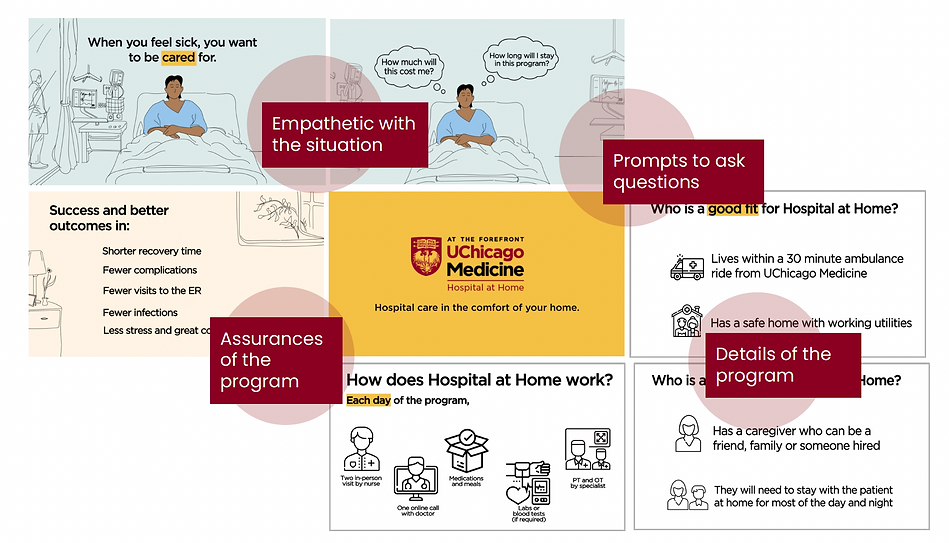Communicating and educating patients and caregivers enrolled in the Hospital at Home Program
Aug - Nov 2022 | UChicago Medicine (Sponsored Workshop) | Team of Five (Alison, Andrew, Diana, Smrti, and Myself - Design Researcher)

Project Overview

Our 2022 Fall Communication Design Workshop class took previously generated research data to develop a communication plan, generate multiple communication vehicle concepts and prototype select pieces for evaluation and subsequent refinement or implementation.
Throughout the course, the entire class delivered an Introduction pamphlet, Introduction video, Hospital at Home Information kits, Informative booklet, Instruction manual, and Care at the Home checklist.
Hospital at Home Program
The team at ID along with UCMC developed a comprehensive Hospital at Home Service Blueprint for optimal delivery of the program, including all steps, tools, staff, and practices involved in delivering the service. They analyze the Blueprint to identify potential areas for improvement and optimization.
Our Objectives
-
Utilize the Hospital at Home Service Blueprint to identify communication opportunities within the patient experience, in collaboration with the ID team and UCMC.
-
Identify key experiential factors for each stage of the Hospital at Home program to inform the design of communication touchpoints and informational materials.
-
Gain a comprehensive understanding of the three-time points in the Hospital at Home program in order to generate prototype ideas for effective communication and engagement with patients and caregivers.

My responsibility
To orient the patient and the caregiver to the program and help them be informed enough to sign the consent form. It would also provide additional information on the program, related to the patient-caregiver experience as soon as they enroll in the program.
When is it used?
Once medical eligibility is confirmed and pre-consent, the
pamphlet and videos are used by nurses as a tool to convey
details of the program to patients and caregivers.
The goal of these materials will be to help patients and caregivers make informed decisions and sign the consent form.
Final Outcome
Yes, the intro video provides a good overview. I’d show this video to a few people who don’t know anything about H@H and see what they say, which could be instructive!. But I do feel like I’ve come away with the key ideas.
- Patty (Former Exhibit and Program Effectiveness Consultant)
The program was successfully launched and the first patient, a 90-year-old with congestive heart failure and a 75-year-old caregiver, was admitted and consented to use the patient materials...The patient did so well in the program that they were discharged early and able to comfortably recover in the comfort of their own home. The success of the program was praised by the patient and caregiver during virtual visits with the doctor.
- Prof.Kim Erwin (Associate Professor of Healthcare Design at IIT ID)
The Process
Background
Understand and design for a patient who will be exposed to the Hospital-at-Home program for the first time. Moreover, most of the patients are over 65 years old, so we needed to think about communicating the information in a simple, direct, and easy-to-understand way.

Video as a medium
We also identified that a video can act as the right medium to convey complex information in a simplified manner.
Final Design Considerations
The introduction video’s function is to help support the introduction brochure and orient the pt/cg who are new to this exp.
It’s a companion piece where it provides additional information on the program related to both the patient and the caregiver experience.
Before I proceed to reflect upon the function of the video, let’s all take a look at it.
● Provide patients reassurance regarding program logistics and experience
● Answer commonly asked questions
● Ensure comprehension via visual-verbal redundancy
Design and Implementation.
Begin with a script and iterate until the tone, length and language are set in place.
TONE
- to give reassurance about success of the program to the patient watching this video
- to help convey the credibility of the program
- to help patients converse with the triage nurse or care team
LENGTH
- to keep it under 3 mins of duration
- to keep it concise and clear with smooth transitions within the content
LANGUAGE
- to use subject-driven sentences (compound sentences & pronouns increase reading level)
- make it in separate sentences, shorter sentences reduce the reading grade level
- to avoid commas as much as possible
- to avoid “selling” the service which comes with the use of second-person pronouns
- to use a third-person point of view and shift to a second person only if required



Drafting a storyboard to set the imagery in place
IMAGERY
- making sure the team is as diverse as possible
- amplifying the use of negative and positive spaces
- to keep in mind the audience, think about the screen-to-image and text ratio
- visual-verbal redundancy
- clean and simple effect even with the use of simple line illustrations
- think of the brand (UCM) and follow their perspective on imagery

Flow and production
Synchronize the audio with each screen of the presentation, ensuring that the illustrations are effective in conveying the appropriate amount of information.

For more information feel free to contact me 💬

